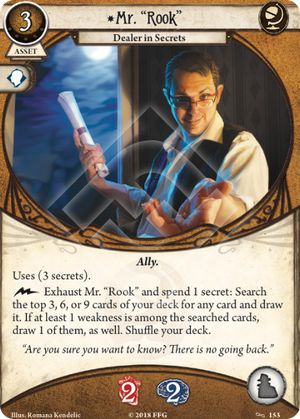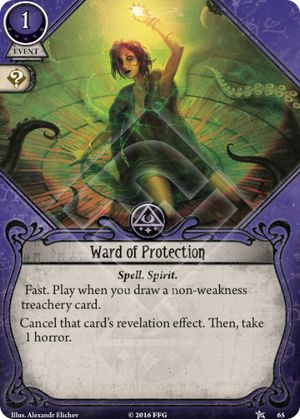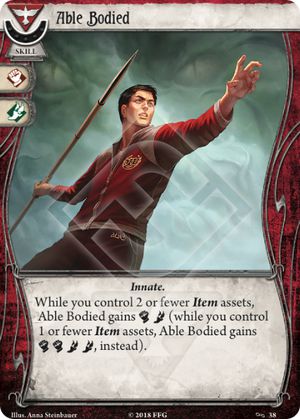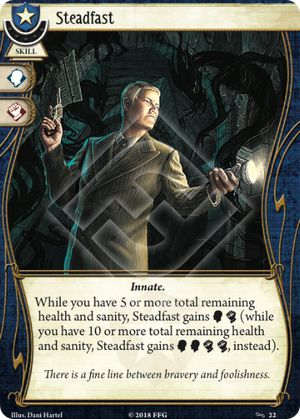
Mr. "Rook" flew under my radar until I tried to use it and realized how strong he is.
You basically get 3 uses of a better No Stone Unturned for 3 resources, this is just great. And, as other reviews put it, drawing your weakness early is actually often an upside. On top of that, you still get to draw a card even when you find your weakness, when normally drawing your weakness would rob you of one card. In the rare situations that you really do not want to risk drawing your weakness and thus can't use Mr. Rook's ability, or when he's out of charges, he still makes a more than decent meat shield with a 2/2 body, the additional health being of a particular note for a Seeker ally.
To further develop on the review analyzing each basic weakness, let's analyze more in depth each investigator's signature weakness and see how using Rook will affect this investigator in this context: how bad (or good) it is to draw your weakness, and (where appropriate) what could you fish in your deck to reduce the severity of your weakness. The review will thus not focus on whether Rook is worth the deck slot and should be selected instead of other cards (like a Dunwich investigator's wild slot) as this would make for a much larger review and would depend too much on deckbuilding.
Seeker
- Daisy Walker - The Necronomicon - Though Daisy's weakness would rob her of one of hands, maybe at the worst possible moment, her capabilities often largely ofset this issue. WIth a 5 , she does not rely on Magnifying Glass and isn't really using her hands for anything but books. Besides, as she gets only 1 free action per turn for using books, she tends not to run 2 in her decks, so in the end losing a hand is never really an issue. On top of that, her ability is nice but not great, and changing it into an token does not significantly decrease your chance of passing tests. Drawn early, you will probably have time to clear the The Necronomicon should you wish to do so, and drawn late your chances are high that it will not make you fail any test. My experience with Daisy is that she will often run two Old Book of Lore (or sometimes Encyclopedia) and no other hand asset, making her weakness moot and she will simply ignore it if she draws it. Considering the very low impact of this weakness, drawing it never really is an issue and you can be free to use Mr. "Rook" without fear. Should you wish to try so, Rook may even open alternatives deckbuilding strategies. Indeed, you could run other hand assets without risking of losing them as you would draw The Necronomicon earlier in scenarios and would just have to clean it and be rid of it, or you could search for Daisy's Tote Bag (a card that you can't really rely on when playing without Rook and most often ending up being committed for its icons) to solve any potential issue.
- Joe Diamond - Unsolved Case - Great news, Joe has one less weakness than everyone in his deck as Unsolved Case is part of his hunch deck. You can use and abuse Rook with very little drawback!
- Minh Thi Phan - The King in Yellow - Make sure you can ace a test and have 3 cards to spare, and fish for your weakness. Though you'll probably have to do some set up before being able to use Rook's ability with impunity.
- Norman Withers - Vengeful Hound - Like Min, you may have to do some set up to make sure that you are ready to fight your weakness, but when you are you will be free to use Rook's ability.
- Rex Murphy - Rex's Curse - Nope, you absolutely don't want Rook in a deck where the weakness is recursive!
- Ursula Downs - Call of the Unknown - Same as Rex - don't use Rook when you have a recursive weakness.
Survivors
- "Ashcan" Pete - Wracked by Nightmares. Play your first action exhausting Duke, search your deck with Mr. "Rook" and draw Wracked by Nightmares, and use your final two actions to get rid of it. Voila.
Mystics
- Jim Culver - Final Rhapsody - Jim's weakness if often not worse drawn early than late. If drawn early, at least you'll know exactly with how many damages you have to deal with, while if you have not drawn it you can never be sure of how many sanity/health points you really have left.
- Marie Lambeau - Baron Samedi - On one hand, when fatality count is high, you wouldn't be able to use Rook's ability. On the other hand, and much more interestingly, when fatality count is low, you could safely draw the Baron and get rid of it, while maybe fishing for Mystifying Song to give you even a little bit more time. This actually makes Marie's weakness more manageable.
Guardians
- Carolyn Fern - Rational Thought – Drawn early, Carolyn’s weakness may drop your set up to a slug, while when drawn late it’s impact on the scenario is often negligible. Sure, Rook, can you help finding your horror healing cards, but you won’t be able to pile on resources and even getting rid of Rational Thought when drawn too early may prove difficult.
- Roland Banks - Cover Up – Roland’s weakness is MUCH better drawn early as it will be a lot easier to get rid of it. Getting this weakness near the end of a Scenario is nearly a guaranteed trauma. Thus, Rook would be an excellent pick early, but his ability could be useless when the end of the scenario comes closer, though Roland decks sometimes mitigate their weakness with Forewarned, Quick Study or Dr. William T. Maleson.
- Zoey Samaras - Smite the Wicked - same as Roland, Zoey's weakness is a lot more manageable when drawn early, but is awful late. Rook is thus excellent early, but his ability will probably not be unusable late if you haven't seen your weakness yet. The weakness can be mitigated through Elusive, which Rook can help you to find.
Rogues
- Finn Edwards - Caught Red-Handed - though Finn's weakness is only "semi" recursive, the risk is high that it hits you several times in a scenario (by readying non-hunter enemies or a hunter enemy at your location and thus still returning into the deck). Though when no ennemy are around, Rook can be used with impunity! Still, I really dislike using Rook when I have a recursive weaknesses.
- Jenny Barnes - Searching for Izzie - Like Roland and Zoey, Jenny's weakness is a lot easier to deal with if you draw it early, but disastrous late, though here again fishing Elusive can be of great help.
Neutrals
- Lola Hayes - Crisis of Identity - Not only is Lola's weakness a real nightmare, drawing it with Rook means that you are in a role and will immediately have to discard related assets, including Mr. "Rook". It may also greatly mess up your plans depending on which role you intended to spend your round on. Contrary to the other review, I believe Rook definitly does not fit in a Lola deck, the tempo hit is way too heavy.



